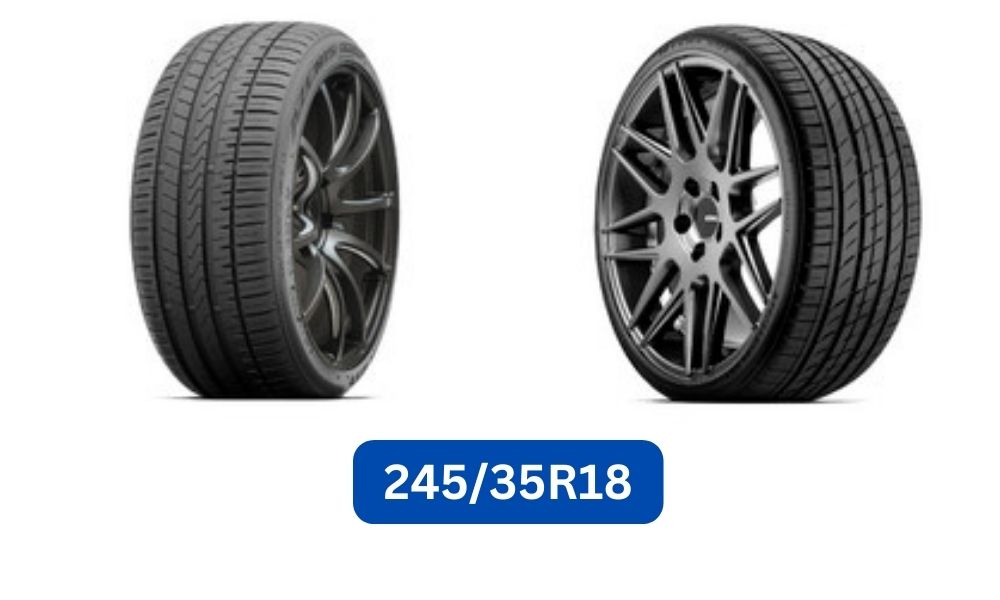When it comes to buying tires for your vehicle, understanding the various numbers and letters on the sidewall can be quite confusing. One of the most common questions that arise is, “What does 245/35r18 mean?” In this article, we will break down the meaning behind these numbers and letters, providing you with a comprehensive understanding of tire sizing and its significance.
Contents
Tire Sizing Basics
Tire sizing is a standardized system used to describe the dimensions and characteristics of a tire. It consists of a series of numbers and letters that provide information about the tire’s width, aspect ratio, construction type, and rim diameter. Let’s start by dissecting the numbers in the 245/35r18 format.
The First Number: 245
The first number in the tire size, 245, represents the tire’s width in millimeters. It is the measurement from one sidewall to the other, indicating the widest point of the tire when properly mounted on a specified rim width. In this case, the tire width is 245 millimeters.
It’s important to note that the actual width of the tire may vary slightly depending on the manufacturer and the rim width it is mounted on. However, the first number provides a general indication of the tire’s width, allowing you to choose a tire that fits your vehicle’s specifications.
Read:What is dealer mode on uconnect?The Second Number: 35
The second number in the tire size, 35, represents the tire’s aspect ratio. The aspect ratio is the ratio of the tire’s sidewall height to its width. In this case, the aspect ratio is 35, meaning that the sidewall height is 35% of the tire’s width.
A lower aspect ratio, such as 35, indicates a shorter sidewall and a wider tire. This type of tire is commonly found on performance vehicles, as it provides better handling and responsiveness due to the reduced flex in the sidewall. However, it also means that the ride may be slightly harsher compared to tires with a higher aspect ratio.
The Letter: R
The letter “R” in the tire size stands for “Radial.” Radial tires are the most common type of tire construction used today. They are constructed with layers of fabric and steel cords that run radially from bead to bead, providing excellent stability and grip on the road.
Radial tires offer numerous advantages over bias-ply tires, including better fuel efficiency, improved handling, and a smoother ride. The majority of modern vehicles are equipped with radial tires, making them the standard choice for most drivers.
Read:What does engine derate in 3 hours mean?The Last Number: 18
The last number in the tire size, 18, represents the diameter of the rim in inches. It indicates the size of the wheel that the tire is designed to fit. In this case, the tire is suitable for a rim with an 18-inch diameter.
It’s crucial to ensure that the tire size matches the rim size specified by the vehicle manufacturer. Using a tire with an incorrect rim diameter can lead to poor handling, increased wear, and potential safety hazards.
Putting It All Together
Now that we have broken down the individual components of the tire size, let’s put it all together. In the case of 245/35r18, the tire has a width of 245 millimeters, an aspect ratio of 35%, and is designed to fit a rim with an 18-inch diameter. Additionally, the tire is of radial construction, which is the most common and widely used type of tire.
Why Does Tire Size Matter?
Understanding tire sizing is crucial for several reasons:
- Compatibility: Choosing the correct tire size ensures that the tire fits properly on the rim and is compatible with your vehicle.
- Performance: Different tire sizes can significantly impact your vehicle’s performance, including handling, braking, and fuel efficiency.
- Safety: Using the wrong tire size can compromise your safety on the road, leading to reduced traction, poor handling, and an increased risk of accidents.
- Warranty: Many tire manufacturers specify the approved tire sizes for their vehicles. Using a non-approved size may void the tire warranty.
Choosing the Right Tire Size
When selecting tires for your vehicle, it’s essential to choose the right size based on your driving needs and the manufacturer’s recommendations. Here are a few factors to consider:
Read:What Does Parked Regen Inhibited Mean?- Vehicle Specifications: Consult your vehicle’s owner’s manual or the tire placard located on the driver’s side door jamb for the recommended tire size.
- Driving Conditions: Consider the climate, road conditions, and your typical driving style when choosing a tire size. For example, if you live in an area with harsh winters, you may want to consider a tire size suitable for winter driving.
- Performance Requirements: If you prioritize performance and handling, you may opt for a lower aspect ratio and wider tire size. However, keep in mind that this may result in a firmer ride.
- Budget: Tire sizes can vary in price, so consider your budget when selecting the right size. However, it’s important not to compromise safety and performance for cost savings.
Conclusion
Understanding tire sizing is essential for every vehicle owner. The numbers and letters on the sidewall of a tire provide valuable information about its width, aspect ratio, construction type, and rim diameter. By decoding the 245/35r18 format, we can determine that the tire has a width of 245 millimeters, an aspect ratio of 35%, and is designed to fit an 18-inch rim. Additionally, the tire is of radial construction, which is the most common type of tire used today.
Choosing the right tire size is crucial for compatibility, performance, and safety. It’s important to consult your vehicle’s specifications and consider factors such as driving conditions, performance requirements, and budget when selecting the appropriate tire size. By doing so, you can ensure optimal performance, safety, and longevity for your vehicle’s tires.








